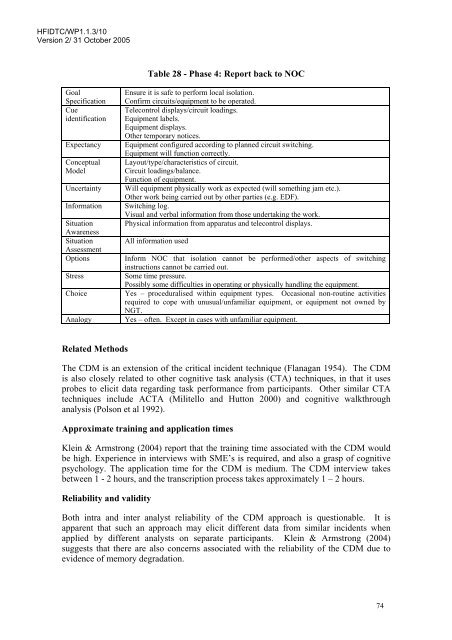A Review of the Event Analysis of Systemic Teamwork Methodology
A Review of the Event Analysis of Systemic Teamwork Methodology
A Review of the Event Analysis of Systemic Teamwork Methodology
- No tags were found...
Create successful ePaper yourself
Turn your PDF publications into a flip-book with our unique Google optimized e-Paper software.
HFIDTC/WP1.1.3/10<br />
Version 2/ 31 October 2005<br />
Table 28 - Phase 4: Report back to NOC<br />
Goal<br />
Specification<br />
Cue<br />
identification<br />
Expectancy<br />
Conceptual<br />
Model<br />
Uncertainty<br />
Information<br />
Situation<br />
Awareness<br />
Situation<br />
Assessment<br />
Options<br />
Stress<br />
Choice<br />
Analogy<br />
Ensure it is safe to perform local isolation.<br />
Confirm circuits/equipment to be operated.<br />
Telecontrol displays/circuit loadings.<br />
Equipment labels.<br />
Equipment displays.<br />
O<strong>the</strong>r temporary notices.<br />
Equipment configured according to planned circuit switching.<br />
Equipment will function correctly.<br />
Layout/type/characteristics <strong>of</strong> circuit.<br />
Circuit loadings/balance.<br />
Function <strong>of</strong> equipment.<br />
Will equipment physically work as expected (will something jam etc.).<br />
O<strong>the</strong>r work being carried out by o<strong>the</strong>r parties (e.g. EDF).<br />
Switching log.<br />
Visual and verbal information from those undertaking <strong>the</strong> work.<br />
Physical information from apparatus and telecontrol displays.<br />
All information used<br />
Inform NOC that isolation cannot be performed/o<strong>the</strong>r aspects <strong>of</strong> switching<br />
instructions cannot be carried out.<br />
Some time pressure.<br />
Possibly some difficulties in operating or physically handling <strong>the</strong> equipment.<br />
Yes – proceduralised within equipment types. Occasional non-routine activities<br />
required to cope with unusual/unfamiliar equipment, or equipment not owned by<br />
NGT.<br />
Yes – <strong>of</strong>ten. Except in cases with unfamiliar equipment.<br />
Related Methods<br />
The CDM is an extension <strong>of</strong> <strong>the</strong> critical incident technique (Flanagan 1954). The CDM<br />
is also closely related to o<strong>the</strong>r cognitive task analysis (CTA) techniques, in that it uses<br />
probes to elicit data regarding task performance from participants. O<strong>the</strong>r similar CTA<br />
techniques include ACTA (Militello and Hutton 2000) and cognitive walkthrough<br />
analysis (Polson et al 1992).<br />
Approximate training and application times<br />
Klein & Armstrong (2004) report that <strong>the</strong> training time associated with <strong>the</strong> CDM would<br />
be high. Experience in interviews with SME’s is required, and also a grasp <strong>of</strong> cognitive<br />
psychology. The application time for <strong>the</strong> CDM is medium. The CDM interview takes<br />
between 1 - 2 hours, and <strong>the</strong> transcription process takes approximately 1 – 2 hours.<br />
Reliability and validity<br />
Both intra and inter analyst reliability <strong>of</strong> <strong>the</strong> CDM approach is questionable. It is<br />
apparent that such an approach may elicit different data from similar incidents when<br />
applied by different analysts on separate participants. Klein & Armstrong (2004)<br />
suggests that <strong>the</strong>re are also concerns associated with <strong>the</strong> reliability <strong>of</strong> <strong>the</strong> CDM due to<br />
evidence <strong>of</strong> memory degradation.<br />
74
















